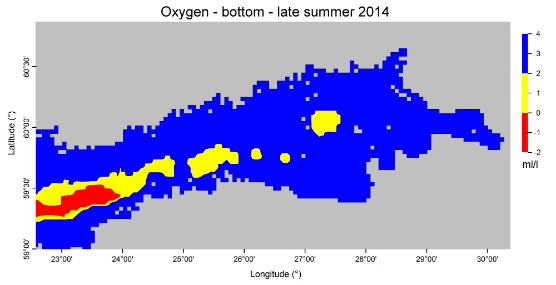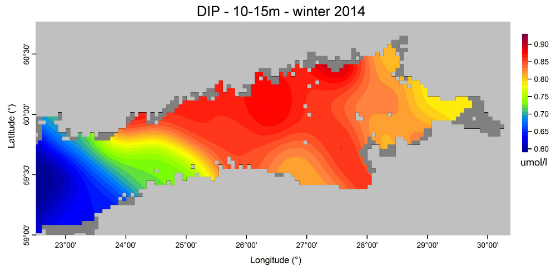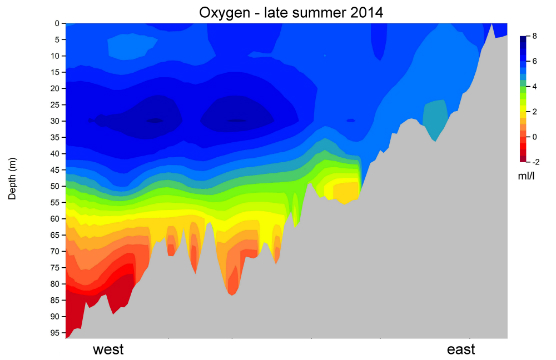Press release 2015-02-03 at 15:32

A clearer picture of the scope of anoxic areas in the Gulf of Finland emerged from the combined data. Completely anoxic water (red) or water with very low oxygen levels (yellow) was observed in the western Gulf of Finland in particular.
“This was the first time that these three countries have combined their surveys to form a more detailed and extensive understanding of the physical, chemical and biological state of the gulf, particularly its eastern parts. The study also provided new information on the effects of the Baltic Proper on the western parts of the Gulf of Finland,” says Kai Myrberg of the Finnish Environment Institute SYKE, who is also the Leading Researcher and Project Manager for the Gulf of Finland Year.
Observations confirm earlier results from the Gulf of Finland
The observational data now collected supports the results of SYKE's own survey excursions. These revealed exceptionally poor oxygen conditions in the deep waters of the western and central Gulf of Finland, and significantly higher-than-average phosphorus levels in the spring and summer of 2014. Assessments of Russian territorial waters suggest that the recent reduction in phytoplankton quantities observed on the Finnish side is also observable in the easternmost and north-eastern Gulf of Finland.
“The situation in the western and central parts of the Gulf of Finland was caused by the entry of oxygen-deficient and phosphorus-rich water which, in the water layers close to the sea floor, extended from the main basin of the Baltic Sea all the way to the area east of Gogland island,” says Senior Research Scientist Mika Raateoja. “The Baltic Proper has a major impact on the status of the Gulf of Finland. It will be interesting to see how the recent major salt intrusion into the Baltic Sea affects the oxygen conditions and trophic status of the Gulf of Finland in the long run,” says a thoughtful Mika.
Field excursions in October revealed that the phosphorus stored in the layer of water close to the sea floor had already partially mixed with the upper levels, particularly along the Estonian coast. The current high amount of phosphorus in the Gulf of Finland may cause blue-green algae to bloom in the coming summer.
Reduced loads from Russia seem to have improved the status of the eastern Gulf of Finland. In August 2014, the concentration of chlorophyll, which corresponds to the amount of algae, was clearly lower than the long-term average across the entire easternmost and north-eastern Gulf of Finland. Algae levels were also lower than normal in the central and eastern offshore areas.

Observed levels of phosphorus nutrient at surface level in the Gulf of Finland in January 2014. The observed concentration level does not vary greatly from long-term average levels, except in the eastern parts of the gulf where it is lower. The peak in the nutrient level due to winter storms is mixing the nutrients accumulated in deep waters with surface waters, at a time when there are low levels of nutrient-consuming phytoplankton.

This longitudinal cross-section reveals a spit of oxygen-deficient water stretching out near the sea floor from the Baltic Proper into the Gulf of Finland.
An extensive monitoring programme in the Gulf of Finland Year 2014
The countries conducted four joint monitoring surveys during the Gulf of Finland Year, visiting almost a hundred sampling sites during each of them. These surveys took place in January, May–July, August and October–November. Monitored parameters included temperature, visibility depth, salinity, nutrients, acidity, chlorophyll a as well as phytoplankton, zooplankton and zoobenthos taxonomy and the corresponding quantities.
The research vessels Aranda from Finland, Salme from Estonia and CH 1303B from Russia were used for monitoring. “Based on our positive experiences of the joint surveys, we intend to continue joint monitoring and research in 2015,” says Myrberg. A more extensive assessment of the status of the Gulf of Finland will be published in late 2015, based on Finnish, Estonian and Russian research and long-term data collected from the gulf.
The Gulf of Finland Year 2014 was a joint project between Finland, Estonia and Russia. It was intended to lead to swift action to improve the condition of the Gulf of Finland. The theme year has raised awareness of the necessity and urgency of the Gulf of Finland and the Baltic Sea protection, as well as increased understanding of marine activities. The findings of the conducted studies will be reported in 2015.
Links
More information
Mika Raateoja, Senior Research Scientist, SYKE
p. 0295 251 536
firstname.surname@ymparisto.fi
Kai Myrberg, Leading Researcher and Project Manager for the Gulf of Finland Year 2014, SYKE
p. 0295 251 441
firstname.surname@ymparisto.fi
Saara Reinimäki, Communications Specialist, SYKE
p. 0295 251 613
firstname.surname@ymparisto.fi